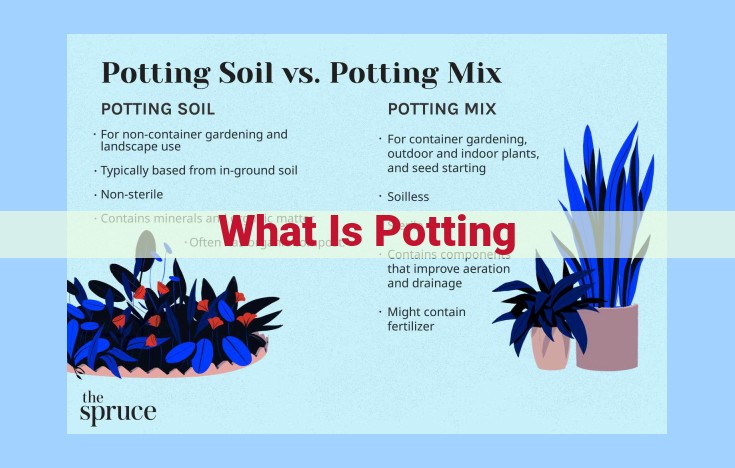Comprehensive Guide To Potting: Creating Ideal Environments For Container Gardening

Potting involves creating an optimal environment for plants in containers by providing essential components such as soil, fertilizer, drainage material, and mulch. It also includes supplementary elements like pots, container gardening, hanging baskets, vertical gardening, controlled environments, and enhanced plant growth techniques. Regular maintenance activities such as watering, fertilizing, pest and disease control, pruning, and repotting ensure the health and longevity of potted plants.
Potting Basics: The Essential Components for Success
When it comes to potting, understanding the essential components is paramount. These elements form the foundation for healthy and thriving potted plants.
Soil: The Vital Foundation
Soil is the lifeline of your potted plant. It provides nutrients, moisture, and support. Choose a well-draining potting mix specifically designed for container gardening. Look for a mix that contains a balance of organic materials like peat moss, compost, or coco coir to retain moisture and aerate the roots.
Fertilizer: Nourishment for Growth
Fertilizer provides essential nutrients to your plant. Choose a balanced, slow-release fertilizer designed for container plants. Follow the directions carefully to avoid over-fertilizing, which can damage your plant.
Drainage Material: Preventing Waterlogging
Proper drainage is crucial to prevent waterlogging, which can lead to root rot. Place a layer of gravel, perlite, or broken pottery at the bottom of your pot to facilitate drainage. This layer ensures excess water can escape, creating a healthier environment for your plant’s roots.
Mulch: Insulation and Moisture Retention
Mulch serves a dual purpose: it insulates the soil from temperature fluctuations and retains moisture, reducing the frequency of watering. Use organic materials like bark chips, shredded leaves, or straw as mulch. Spread a thin layer around the base of your plant, keeping it away from the stem to prevent rot.
Supplementary Elements for Enhancing Potting
Potting is an art with endless possibilities, where you can create a thriving ecosystem for your cherished plants within confined spaces. Beyond the basics, various supplementary elements can elevate your potting game and enhance the well-being of your botanical companions.
Selecting the Right Pot
The choice of pot plays a crucial role in the success of your potted plants. Consider the size, shape, and material to accommodate root growth and promote drainage. Clay, terracotta, and ceramic pots are popular choices, offering breathability and moisture regulation. For outdoor use, opt for frost-resistant materials like glazed ceramic or plastic.
Container Gardening
Container gardening expands the boundaries of potting, allowing you to grow a wide variety of plants in limited spaces. From spacious raised beds to hanging baskets, containers offer versatility and mobility. Vertical gardening, with its upward growth pattern, maximizes space and creates living walls.
Controlled Environment
For precise control over temperature, humidity, and lighting, consider creating a controlled environment for your potted plants. Greenhouses, grow rooms, and indoor gardens allow you to optimize conditions for specific species or during seasonal changes. This meticulous approach enables you to cultivate exotic plants or nurture seedlings in optimal conditions.
Enhanced Plant Growth
Supplementing your potting mix with nutrient-rich additives can boost plant growth and improve resistance to pests and diseases. Organic fertilizers, such as compost and manure, provide a slow release of nutrients. Mycorrhizal fungi can enhance root absorption, while sphagnum moss and perlite promote aeration and moisture retention.
Remember, the key to successful potting lies not only in the essential components but also in the creative and resourceful use of supplementary elements. By carefully considering the needs of your plants and incorporating these enhancements, you can transform your pots into verdant havens of thriving greenery.
Maintenance for Healthy Potted Plants
Caring for potted plants is a rewarding hobby that brings beauty and life to homes and gardens. But to ensure your potted companions thrive, they require regular maintenance and attention. Let’s delve into the essential maintenance practices to keep your potted plants vibrant and healthy.
Watering
The amount and frequency of watering will vary depending on the type of plant, pot size, climate, and season. However, a good rule of thumb is to water thoroughly when the soil feels dry to the touch an inch or two below the surface. Avoid overwatering, as soggy soil can lead to root rot.
Fertilizing
Potted plants need regular fertilization to replenish the nutrients depleted from the soil. Fertilize your plants every two to four weeks with a balanced liquid fertilizer during the growing season. Choose a fertilizer specifically formulated for potted plants, as they often have a higher concentration of nutrients than fertilizers intended for garden plants.
Pest and Disease Control
Monitor your plants regularly for pests and diseases. Inspect the leaves, stems, and soil for signs of infestation or infection. If you notice any problems, treat them promptly with an appropriate pesticide or fungicide. Early detection and treatment can prevent the spread of pests and diseases and keep your plants healthy.
Pruning
Regular pruning is crucial for maintaining the shape and health of your potted plants. Remove dead or diseased leaves, stems, and flowers. Trim back overgrown branches to promote new growth and prevent overcrowding. Pruning also encourages bushier growth, resulting in a fuller and more attractive plant.
Repotting
As your potted plants grow, they may require repotting into a larger container. Repotting provides fresh soil, more space for roots, and improves drainage. Repot plants when they become rootbound, which is visible when the roots start circling the inside of the pot or growing out the drainage holes. Choose a pot that is only slightly larger than the current one, as too large a pot can lead to overwatering and root rot.
By following these essential maintenance practices, you can ensure that your potted plants thrive and bring you years of enjoyment. Nurturing your potted companions with regular care and attention is the key to keeping them healthy, vibrant, and a beautiful addition to your indoor or outdoor space. Remember, a little bit of love and care goes a long way in creating a thriving potted paradise.